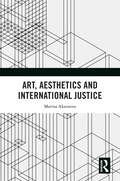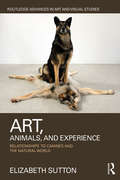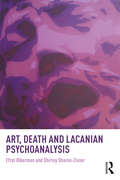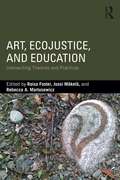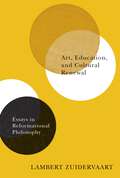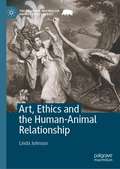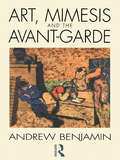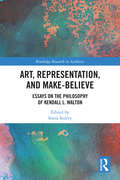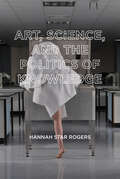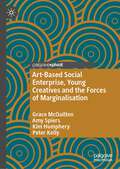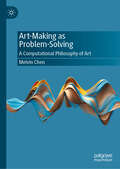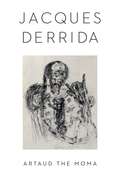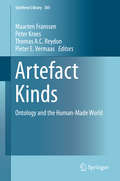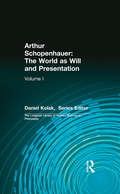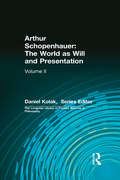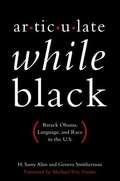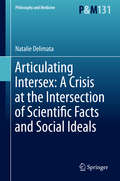- Table View
- List View
Art, Aesthetics and International Justice
by Marina AksenovaThis book demonstrates that art is implicit in the process of administration of international justice. The diverse nature of recent global threats as well as an overwhelming pull towards isolationism and nationalism challenge the dominant deterrence paradigm of international governance created in the aftermath of the Second World War. An alternative model is to focus on cooperation, and not deterrence, as a guiding operational principle.This volume focuses on the theoretical component linking justice with aesthetics as well as on the practical manifestation of such connection evident, inter alia, in the rhetoric of international courts, their architectural design and their commemorative practices expressed by the practice of symbolic reparations adopted by some of the courts. The underlying premise of the book is that international justice requires new vocabulary and new approaches, which can be derived from the study of aesthetics. It is held that exploring the aesthetical dimension of international justice contributes to the discussion on the foundations of its authority and the grounds for compliance with it. The work engages deeply with the theory of aesthetics developed by Immanuel Kant and Abhinavagupta, a Kashmiri critic, philosopher and scholar writing in the early eleventh century.The book will be of interest to academics and researchers working in the areas of Legal Philosophy, International Criminal Justice and International Law and International Relations.
Art, Animals, and Experience: Relationships to Canines and the Natural World (Routledge Advances in Art and Visual Studies)
by Elizabeth SuttonElizabeth Sutton, using a phenomenological approach, investigates how animals in art invite viewers to contemplate human relationships to the natural world. Using Rembrandt van Rijn’s etching of The Presentation in the Temple (c. 1640), Joseph Beuys’s social sculpture I Like America and America Likes Me (1974), archaic rock paintings at Horseshoe Canyon, Canyonlands National Park, and examples from contemporary art, this book demonstrates how artists across time and cultures employed animals to draw attention to the sensory experience of the composition and reflect upon the shared sensory awareness of the world.
Art, Death and Lacanian Psychoanalysis
by Efrat Biberman Shirley Sharon-ZisserArt, Death and Lacanian Psychoanalysis examines the relationship between art and death from the perspective of Lacanian psychoanalysis. It takes a unique approach to the topic by making explicit reference to the death drive as manifest in theories of art and in artworks. Freud’s treatment of death focuses not on the moment of biological extinction but on the recurrent moments in life which he called "the death drive" or the "compulsion to repeat": the return precisely of what is most unbearable for the subject. Surprisingly, in some of its manifestations, this painful repetition turns out to be invigorating. It is this invigorating repetition that is the main concern of this book, which demonstrates the presence of its manifestations in painting and literature and in the theoretical discourse concerning them from the dawn of Western culture to the present. After unfolding the psychoanalytical and philosophical underpinnings for the return of the death drive as invigorating repetition in the sphere of the arts, the authors examine various aspects of this repetition through the works of Gerhard Richter, Jeff Wall, and contemporary Israeli artists Deganit Berest and Yitzhak Livneh, as well as through the writings of Virginia Woolf and James Joyce. First to articulate the stimulating aspect of the death drive in its relation to the arts and the conception of art as a varied repetition beyond a limit, Art, Death and Lacanian Psychoanalysis will be indispensable to psychoanalysts, scholars of art theory and aesthetics and those studying at the intersection of art and psychoanalysis.
Art, EcoJustice, and Education: Intersecting Theories and Practices
by Rebecca A. Martusewicz Raisa Foster Jussi MäkeläEmphasizing the importance of contemporary art forms in EcoJustice Education, this book examines the interconnections between social justice and ecological well-being, and the role of art to enact change in destructive systems. Artists, educators, and scholars in diverse disciplines from around the world explore the power of art to disrupt ways of thinking that are taken for granted and dominate modern discourses, including approaches to education. The EcoJustice framework presented in this book identifies three strands—cultural ecological analysis, revitalizing the commons, and enacting imagination—that help students to recognize the value in diverse ways of knowing and being, reflect on their own assumptions, and develop their critical analytic powers in relation to important problems. This distinctive collection offers educators a mix of practical resources and inspiration to expand their pedagogical practices. A Companion Website includes interactive artworks, supplemental resources, and guiding questions for students and instructors.
Art, Education, and Cultural Renewal: Essays in Reformational Philosophy
by Lambert ZuidervaartA call for solidarity and renewal in the arts and the academy.
Art, Ethics and the Human-Animal Relationship (The Palgrave Macmillan Animal Ethics Series)
by Linda JohnsonThis book examines the works of major artists between the seventeenth and nineteenth centuries, as important barometers of individual and collective values toward non-human life. Once viewed as merely representational, these works can also be read as tangential or morally instrumental by way of formal analysis and critical theories. Chapter Two demonstrates the discrimination toward large and small felines in Genesis and The Book of Revelation. Chapter Three explores the cruel capture of free roaming animals and how artists depicted their furs, feathers and shells in costume as symbols of virtue and vice. Chapter Four identifies speciest beliefs between donkeys and horses. Chapter Five explores the altered Dutch kitchen spaces and disguised food animals in various culinary constructs in still life painting. Chapter Six explores the animal substances embedded in pigments. Chapter Seven examines animals in absentia-in the crafting of brushes. The book concludes with the fish paintings of William Merritt Chase whose glazing techniques demonstrate an artistic approach that honors fishes as sentient beings.
Art, Excess, and Education: Historical and Discursive Contexts (Palgrave Studies in Educational Futures)
by Kevin Tavin Mira Kallio-Tavin Max RyynänenThis book concentrates on the deep historical, political, and institutional relationships between art, education, and excess. Going beyond field specific discourses of art history, art criticism, philosophy, and aesthetics, it explores how the concept of excess has been important and enduring from antiquity through contemporary art, and from early film through the newer interactive media. Examples considered throughout the book focus on disgust, grandiosity, sex, violence, horror, disfigurement, endurance, shock, abundance, and emptiness, and frames them all within an educational context. Together they provide theories and classificatory systems, historical and political interpretations of art and excess, examples of popular culture, and suggestions for the future of educational practice.
Art, Literature, and Passions of the Skies: Art, Literature, And Passions Of The Skies (Analecta Husserliana #112)
by Anna Teresa TymienieckaFlashes of lightning, resounding thunder, gloomy fog, brilliant sunshine...these are the life manifestations of the skies. The concrete visceral experiences that living under those skies stir within us are the ground for individual impulses, emotions, sentiments that in their interaction generate their own ever-changing clouds. While our intellect concentrates on the discovery of our cosmic position, on the architecture of the universe, our imagination is informed by the gloomy vapors, the glimmers of fleeting light, and the glory of the skies. Reconnoitering from the soil of human life and striving towards the infinite, the elan of imagination gets caught up in the clouds of the skies. There in that dimness, sensory receptivity, dispositions, emotions, passionate strivings, yearnings, elevations gather and propagate. From the "Passions of the Skies" spring innermost intuitions that nourish literature and the arts.
Art, Mimesis and the Avant-Garde: Aspects of a Philosophy of Difference
by Andrew BenjaminFirst published in 1991. Routledge is an imprint of Taylor & Francis, an informa company.
Art, Representation, and Make-Believe: Essays on the Philosophy of Kendall L. Walton (Routledge Research in Aesthetics)
by Sonia SedivyThis is the first collection of essays focused on the many-faceted work of Kendall L. Walton. Walton has shaped debate about the arts for the last 50 years. He provides a comprehensive framework for understanding arts in terms of the human capacity of make-believe that shows how different arts – visual, photographic, musical, literary, or poetic – can be explained in terms of complex structures of pretense, perception, imagining, empathy, and emotion. His groundbreaking work has been taken beyond aesthetics to address foundational issues concerning linguistic and scientific representations – for example, about the nature of scientific modelling or to explain how much of what we say is quite different from the literal meanings of our words. Contributions from a diverse group of philosophers probe Walton’s detailed proposals and the themes for research they open. The essays provide an overview of important debates that have Walton’s work at their core. This book will be of interest to scholars and graduate students working on aesthetics across the humanities, as well as those interested in the topic of representation and its intersection with perception, language, science, and metaphysics.
Art, Science, and the Politics of Knowledge
by Hannah Star RogersHow the tools of STS can be used to understand art and science and the practices of these knowledge-making communities.In Art, Science, and the Politics of Knowledge, Hannah Star Rogers suggests that art and science are not as different from each other as we might assume. She shows how the tools of science and technology studies (STS) can be applied to artistic practice, offering new ways of thinking about people and objects that have largely fallen outside the scope of STS research. Arguing that the categories of art and science are labels with specific powers to order social worlds—and that art and science are best understood as networks that produce knowledge—Rogers shows, through a series of cases, the similarities and overlapping practices of these knowledge communities. The cases, which range from nineteenth-century artisans to contemporary bioartists, illustrate how art can provide the basis for a new subdiscipline called art, science, and technology studies (ASTS), offering hybrid tools for investigating art–science collaborations. Rogers&’s subjects include the work of father and son glassblowers, the Blaschkas, whose glass models, produced in the nineteenth century for use in biological classification, are now displayed as works of art; the physics photographs of documentary photographer Berenice Abbott; and a bioart lab that produces work functioning as both artwork and scientific output. Finally, Rogers, an STS scholar and contemporary art–science curator, draws on her own work to consider the concept of curation as a form of critical analysis.
Art-Based Social Enterprise, Young Creatives and the Forces of Marginalisation
by Peter Kelly Kim Humphery Grace McQuilten Amy SpiersThis book analyses the challenges and opportunities faced by art-based social enterprises (ASEs) engaging young creatives in education and training and supporting their pathways to the creative industries. In doing so, it addresses the complex intersecting issues of marginality and entrepreneurship, particularly in relation to young creatives from socially, economically and culturally diverse backgrounds. Drawing on extensive fieldwork and interviews with twelve key organisations, and three in-depth case studies in Australia, the book offers a detailed analysis of using enterprise to engage with the structural challenges of marginality. The book explores the local and global contexts through which art-based social enterprises (ASEs) operate and within which they attempt – often successfully – to improve access to education and work for emerging creatives. It also attends to the findings generated through engaging with the lived experiences of the staff and young creatives involved in our ASE case studies, in order to understand both the challenges and impacts of the ASE model on young people’s education, training, and employment pathways. The book focuses on three broad themes; precarious youth and digital futures, material practice and sustainable economies, and cultural citizenship in the urban fringe. In exploring these themes, the book contributes to debates about the limits, possibilities and challenges that attach to, and emerge from, an ASE model and highlights the ways in which these models can contribute to young people’s well-being, engagement, education and training, and work pathways. More broadly, it examines the possibilities of art as a means of social and cultural engagement. In the context of the precarious future of the creative industries, this book emphasise the ways in which young artists are building alternative economic and cultural models that support both individual pathways and collective change. This book will move the field forward with a critical lens that engages closely with experience and the lived realities of juggling multiple priorities of social, economic and artistic goals.
Art-Making as Problem-Solving: A Computational Philosophy of Art
by Melvin ChenWhat is art-making? What is it in virtue of which an artifact counts as a work of art? In this book, Melvin Chen contends that art-making is best understood in the context of problem-solving. Works of art are various ways in which artists solve problems and overcome obstacles, while typically exhibiting creative thinking. Using the theory of problem-solving, its theoretical milieu, and various philosophical tools, Chen builds a robust, coherent, and consistent computationalist approach to art-making and the production of works of art. This computationalist approach to art-making and the production of works of art, in turn, is articulated against the backdrop of an information-theoretic philosophy of art. This computationalist approach takes discussions in the philosophy of art into the twenty-first century.
Artaud the Moma (Columbia Themes in Philosophy, Social Criticism, and the Arts)
by Jacques DerridaIn 1996 Jacques Derrida gave a lecture at the Museum of Modern Art in New York on the occasion of Antonin Artaud: Works on Paper, one of the first major international exhibitions to present the avant-garde dramatist and poet's paintings and drawings. Derrida's original title, "Artaud the Moma," is a characteristic play on words. It alludes to Artaud's calling himself Mômo, Marseilles slang for "fool," upon his return to Paris in 1946 after nine years in various asylums, while playing off of the museum's nickname, MoMA. But the title was not deemed "presentable or decent," in Derrida's words, by the very institution that chose to exhibit Artaud's work. Instead, the lecture was advertised as "Jacques Derrida . . . will present a lecture about Artaud's drawings."For Derrida, what was at stake was what it meant for the museum to exhibit Artaud's drawings and for him to lecture on Artaud in that institutional context. Thinking over the performative force of Artaud's work and the relation between writing and drawing, Derrida addresses the multiplicity of Artaud's identities to confront the modernist museum's valorizing of originality. He channels Artaud's specter, speech, and struggle against representation to attempt to hold the museum accountable for trying to confine Artaud within its categories. Artaud the Moma, as lecture and text, reveals the challenge that Artaud posed to Derrida—and to art and its institutional history. A powerful interjection into the museum halls, this work is a crucial moment in Derrida's thought and an insightful, unsparing reading of a challenging writer and artist.
Artefact Kinds: Ontology and the Human-Made World (Synthese Library #365)
by Maarten Franssen Peter Kroes Thomas A.C. Reydon Pieter E. VermaasThis book is concerned with two intimately related topics of metaphysics: the identity of entities and the foundations of classification. What it adds to previous discussions of these topics is that it addresses them with respect to human-made entities, that is, artefacts. As the chapters in the book show, questions of identity and classification require other treatments and lead to other answers for artefacts than for natural entities. These answers are of interest to philosophers not only for their clarification of artefacts as a category of things but also for the new light they may shed on these issue with respect to to natural entities. This volume is structured in three parts. The contributions in Part I address basic ontological and metaphysical questions in relation to artefact kinds: How should we conceive of artefact kinds? Are they real kinds? How are identity conditions for artefacts and artefact kinds related? The contributions in Part II address meta-ontological questions: What, exactly, should an ontological account of artefact kinds provide us with? What scope can it aim for? Which ways of approaching the ontology of artefact kinds are there, how promising are they, and how should we assess this? In Part III, the essays offer engineering practice rather than theoretical philosophy as a point of reference. The issues addressed here include: How do engineers classify technical artefacts and on what grounds? What makes specific classes of technical artefacts candidates for ontologically real kinds, and by which criteria?
Artful Design: Technology in Search of the Sublime, A MusiComic Manifesto
by Ge WangWhat we make, makes us. This is the central tenet of Artful Design, a photorealistic comic book that examines the nature, purpose, and meaning of design. A call to action and a meditation on art, authenticity, and social connection in a world disrupted by technological change, this book articulates a fundamental principle for design: that we should design not just from practical needs but from the values that underlie those needs. Artful Design takes readers on a journey through the aesthetic dimensions of technology. Using music as a universal phenomenon that has evolved alongside technology, this book breaks down concrete case studies in computer-mediated toys, tools, games, and instruments, including the best-selling app Ocarina. Every chapter elaborates a set of general design principles and strategies that illuminate the essential relationship between aesthetics and engineering, art and design. Ge Wang implores us to both embrace and confront technology, not purely as a means to an end, but in its potential to enrich life. Technology is never a neutral agent, but through what we do with it—through what we design with it—it provides a mirror to our human endeavors and values. Artful Design delivers an aesthetic manifesto of technology, accessible yet uncompromising.
Arthur Schopenhauer's English Schooling (Routledge Revivals)
by Patrick BridgwaterOriginally published in 1988 Arthur Schopenhauer’s English Schooling examines the famous German philosopher Arthur Schopenhauer, and his image of England and the influences and experiences which formed that image, notably his visit to England in 1803. His philosophy, when he came to formulate it, showed the pervasive influence of his English reading, was riddled with allusions to his three months at Wimbledon School, and was indeed in many ‘English’ style; above all it was a philosophy designed as a refutation of ‘Christianity’ as understood and practised by his English headmaster, who is the invisible bête noire behind it. In the course of the book two major figures who have hitherto been known only by name are identified and their lives related. The book also examines many background figures in Schopenhauer’s English diary and the letters addressed to him in 1803. This book, which is based on a wide variety of hitherto unknown material from many different sources, will permanently modify our view of his philosophy; it also has important implications for educationalists and for all interest in the history of ideas.
Arthur Schopenhauer: Volume I
by Arthur SchopenhauerPart of the “Longman Library of Primary Sources in Philosophy,” this first volume of Schopenhauer's The World as Will and Presentation is framed by a pedagogical structure designed to make this important work of philosophy more accessible and meaningful for undergraduates.
Arthur Schopenhauer: Volume II
by Arthur SchopenhauerThis second volume of Schopenhauer's World as Will and Presentation is framed by a pedagogical structure designed to make this important work of philosophy more accessible and meaningful for undergraduates. With in-depth, user-friendly introductions, copious notes to clarify difficult or important passages, and a rich index, each volume makes the masterworks of philosophy accessible to students and emphasizes their relevance to contemporary issues and debates.
Articulate While Black: Barack Obama, Language, And Race In The U. S.
by Michael Eric Dyson Geneva Smitherman H. Samy AlimBarack Obama is widely considered one of the most powerful and charismatic speakers of our age. Without missing a beat, he often moves between Washington insider talk and culturally Black ways of speaking--as shown in a famous YouTube clip, where Obama declined the change offered to him by a Black cashier in a Washington, D.C. restaurant with the phrase, "Nah, we straight." <p><p>In Articulate While Black, two renowned scholars of Black Language address language and racial politics in the U.S. through an insightful examination of President Barack Obama's language use--and America's response to it. In this eloquently written and powerfully argued book, H. Samy Alim and Geneva Smitherman provide new insights about President Obama and the relationship between language and race in contemporary society. <p><p>Throughout, they analyze several racially loaded, cultural-linguistic controversies involving the President--from his use of Black Language and his "articulateness" to his "Race Speech," the so-called "fist-bump," and his relationship to Hip Hop Culture. Using their analysis of Barack Obama as a point of departure, Alim and Smitherman reveal how major debates about language, race, and educational inequality erupt into moments of racial crisis in America. <p><p> In challenging American ideas about language, race, education, and power, they help take the national dialogue on race to the next level. In much the same way that Cornel West revealed nearly two decades ago that "race matters," Alim and Smitherman in this groundbreaking book show how deeply "language matters" to the national conversation on race--and in our daily lives.
Articulating Intersex: A Crisis at the Intersection of Scientific Facts and Social Ideals (Philosophy and Medicine #131)
by Natalie DelimataThis book explores the ethical dilemma clinicians may face when disclosing a diagnosis of atypical sex. The moment of disclosure reveals an epistemic incompatibility between scientific fact and social meaning in relation to sex. Attempting to assess the bio-psychosocial implications of this dilemma highlights a complex historic antagonism between fact and meaning making satisfactory resolution of this dilemma difficult. Drawing on David Hume, WVO Quine and Michel Foucault the author presents an integrative model, which views scientific fact and social meaning as codetermining threads in one fabric of knowledge. From this epistemic perspective, the ethical dilemma is understood as a tear in the fabric signifying a rupturing of ontological integrity. To mend this tear and resolve the ethical dilemma three metaphysical perspectives are considered: essentialism, naturalism and emergentism. The book’s unique features include: an exploration of the impact of diagnostic disclosure on people with atypical sex (intersex); a synthesis of the epistemic perspectives of social and natural science facilitating interdisciplinary collaboration; a critical evaluation of three metaphysical perspectives on atypical sex (intersex); the application of Hume’s epistemological and moral distinctions to contemporary biomedicine and bioethics. The book’s target audience includes academics, students and professionals whose work intersects the natural and social sciences, and individuals interested in the metaphysics, epistemology and meta-ethics of sex.
Articulating Reasons: An Introduction to Inferentialism
by Robert B. BrandomThis is a book about the use and content of concepts and an introduction to the author's inferentialist semantics and expressionist conception of logic and philosophy.
Articulating Reasons: An Introduction to Inferentialism
by Robert B. BrandomRobert B. Brandom is one of the most original philosophers of our day, whose book Making It Explicit covered and extended a vast range of topics in metaphysics, epistemology, and philosophy of language--the very core of analytic philosophy. This new work provides an approachable introduction to the complex system that Making It Explicit mapped out. A tour of the earlier book's large ideas and relevant details, Articulating Reasons offers an easy entry into two of the main themes of Brandom's work: the idea that the semantic content of a sentence is determined by the norms governing inferences to and from it, and the idea that the distinctive function of logical vocabulary is to let us make our tacit inferential commitments explicit. Brandom's work, making the move from representationalism to inferentialism, constitutes a near-Copernican shift in the philosophy of language--and the most important single development in the field in recent decades. Articulating Reasons puts this accomplishment within reach of nonphilosophers who want to understand the state of the foundations of semantics.
Articulating the World: Conceptual Understanding and the Scientific Image
by Joseph RouseNaturalism as a guiding philosophy for modern science both disavows any appeal to the supernatural or anything else transcendent to nature, and repudiates any philosophical or religious authority over the workings and conclusions of the sciences. A longstanding paradox within naturalism, however, has been the status of scientific knowledge itself, which seems, at first glance, to be something that transcends and is therefore impossible to conceptualize within scientific naturalism itself. In Articulating the World, Joseph Rouse argues that the most pressing challenge for advocates of naturalism today is precisely this: to understand how to make sense of a scientific conception of nature as itself part of nature, scientifically understood. Drawing upon recent developments in evolutionary biology and the philosophy of science, Rouse defends naturalism in response to this challenge by revising both how we understand our scientific conception of the world and how we situate ourselves within it.
Articulations of Nature and Politics in Plato and Hegel
by Vicky RoupaThis book examines nature as a foundational concept for political and constitutional theory, drawing on readings from Plato and Hegel to counter the view that optimal political arrangements are determined by nature. Focussing on the dialectical implications of the word ‘nature’, i.e. how it encompasses a range of meanings stretching up to the opposites of sensuousness and ideality, the book explores the various junctures at which nature and politics interlock in the philosophies of Plato and Hegel. Appearance and essence, inner life and public realm, the psychical and the political are all shown to be parts of a conflictual structure that requires both infinite proximity and irreducible distance. The book offers innovative interpretations of a number of key texts by Plato and Hegel to highlight the metaphysical and political implications of nature’s dialectical structure, and re-appraises their thinking of nature in a way that both respects and goes beyond their intentions.
